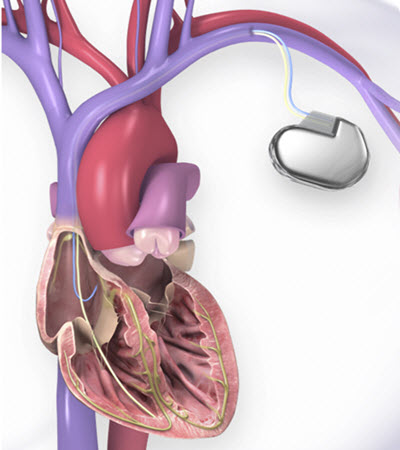Implantable Cardioverter Defibrillator (ICD)
ICDs are useful in preventing sudden death in people who have a high risk of a life-threatening arrhythmia. These include ventricular tachycardia (VT) or ventricular fibrillation (VF).
Most ICDs, called transvenous ICDs, have a dual function and also serve as a pacemaker.

What is an implantable cardioverter defibrillator?
An ICD is a battery-powered device placed under the skin that keeps track of your heart rate. Thin wires connect the ICD to your heart. If an abnormal heart rhythm is detected, the device will deliver an electric shock to restore a normal heartbeat.

An ICD is implanted under the skin, just under the collarbone. It detects arrhythmias and responds with electrical signals to restore your heart’s normal rhythm.
A person is a candidate for an ICD if they have a life-threatening arrhythmia without correctable causes, such as:
- Acute myocardial infarction (heart attack)
- Myocardial ischemia (inadequate blood flow to the heart muscle)
- Electrolyte imbalance and drug toxicity
Why do I need an ICD?
Your health care team may recommend an ICD if you or your child is at risk of a life-threatening ventricular arrhythmia because of:
- Ventricular arrhythmia
- Heart attack
- Surviving a sudden cardiac arrest
- Long QT syndrome
- Brugada syndrome
- A congenital heart disease or other underlying conditions for sudden cardiac arrest
- Cardiac sarcoidosis
How is an ICD implanted?
A battery-powered pulse generator is implanted in a pouch under the skin of the chest, often just below the collarbone, or along your ribs. In infants, it may be placed in the abdomen. The generator is about the size of a pocket watch. Wires or leads run from the pulse generator to positions on the surface of or inside the heart and can be installed through blood vessels, eliminating the need for open-chest surgery.
How does an ICD work?
It detects an abnormal heartbeat and tries to return the heartbeat to normal.
- If your ICD has a pacemaker feature, when your heartbeat is too slow, it works as a pacemaker and sends tiny electric signals to your heart.
- When your heartbeat is too fast or chaotic, it gives defibrillation shocks to stop the abnormal rhythm.
- It works 24 hours a day.
Some devices also provide “overdrive” pacing to electrically convert a sustained ventricular tachycardia (fast heart rhythm) and “backup” pacing if bradycardia (slow heart rhythm) occurs. They also offer other functions, such as storage of detected arrhythmic events. Stored information can help your health care professional optimize the ICD for your needs.
What should I ask my health care professional about living with an ICD?
If you have an ICD, be aware of your surroundings and devices, such as those with strong magnetic fields, that may interfere with its operation. The longer you’re exposed to the potentially interruptive device and the closer it is to your ICD, the more likely it will affect your ICD’s performance. Ask your health care team which machines or equipment you should avoid.
Learn about the electromagnetic compatibility of your ICD and other products with this list of devices that interfere with an ICD.
Also, ask what you can and cannot do when you have an ICD. Read about living with an ICD.
Review ICD Questions to Ask Your Doctor.






